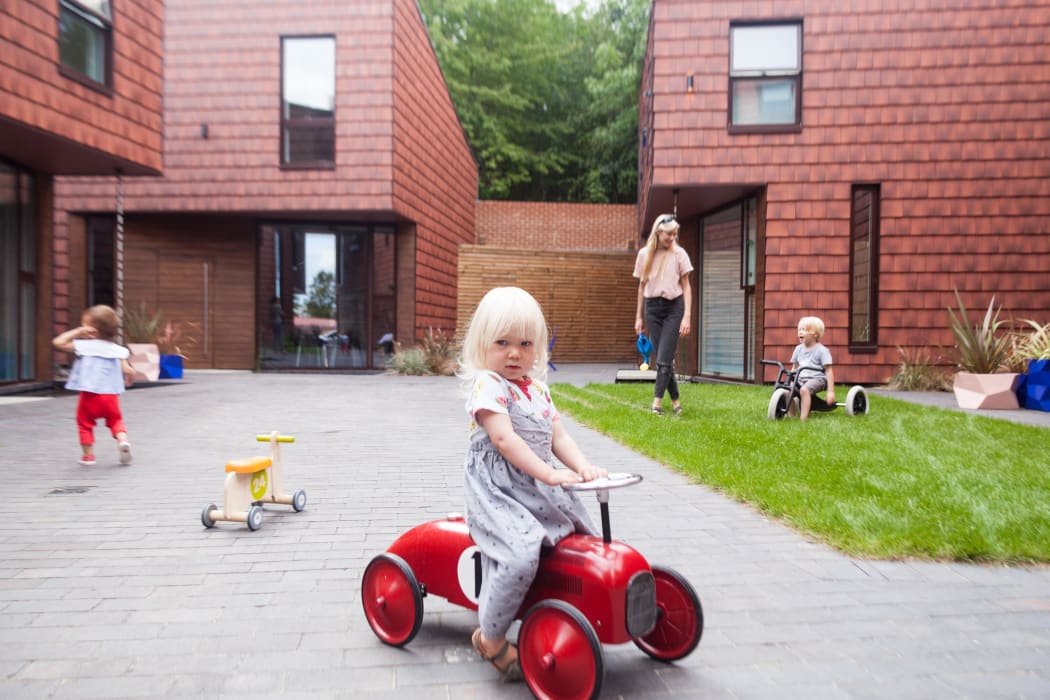
One of the benefits to have come out of the UK lockdown has been the flourishing sense of community experienced by many. Communities have formed around providing support and solidarity in order to survive Covid-19. It is common that many Londoners do not know their immediate neighbours, not to mention the people on their entire street. Yet, since lockdown, new groups have emerged; helping vulnerable members, sharing resources and local knowledge. Having experienced the benefit of being in a connected community, many of these newly formed groups are promising one another to keep the goodwill going, even as lockdown starts to ease.

The visible signs of this ‘togetherness’ are displayed, so joyously, in the change to our streets – the rainbows, the hand-written signs, the knitted coverings on lampposts and bollards; we have allowed the fronts of our houses and our streets to communicate our feelings. A communal, almost village, atmosphere has started to emerge.

Over the last 60 years, despite there being a call for ‘eyes on the streets’, in reality the typical street has become dominated by the motor vehicle, moving and parked. Houses lucky enough to have front gardens have seen these replaced by parking forecourts or depositories for wheelie bins, and the ‘eyes on the street’ have been averted behind a veil of muslin and privacy. To the rear, houses have been extended deep into diminishing, but highly-prized private, gardens that are surrounded by high fences.
Hopefully, despite their general settings, the communities formed will continue to look out for one another.
Looking to the future - how can these communities be supported?
We believe that good design can help people to connect with one another. We call it Sociable Housing.

Sociable Housing is where housing developments are designed with the social aspects in mind, for example play, shared spaces, shared activities. This translates directly into forming small communities.
We have found that having the space to engage with one another in an informal setting helps to engender community spirit. Whilst our experience has been in creating bespoke spaces there are many opportunities within existing neighbourhoods. Making space for chance interactions on the street, and spaces for small gatherings, is possible through selective design interventions like clever street furniture and organised events.
One of the most frequent questions we have been asked about lockdown, is how does it work where you live? We know how we feel about it, but we decided to ask the residents of Forest Mews and Kaolin Court about their experience.
Here is what they have said:
"Living in a communal space and sharing our garden with wonderful families has certainly made our days sunnier (even when the weather was grey) and happier. Initially, we chose to isolate ourselves and only would go out to the garden in turns. After a period of isolation, home-schooling and working from home, all families decided that it was time for our children to play together. We have now a great ‘big family feeling’ and our children are really enjoying playing, digging, gardening, running, jumping and exploring outdoors - together."
“I have never lived in a shared community space before - however this is certainly something that attracted me to living here. In these extraordinary times, there have been moments of warmth and togetherness that I would never have expected. Watching the children play and laugh together as I sit on my 10th work zoom call of the morning, sharing veg box recommendations, planting vegetables and talking about the birds that visit the garden. Lockdown has been a scary and testing time - it has made me question so much, but being able to share even the smallest worries with my close neighbours has helped clear many of those worries away.
“We are isolated, but I am not alone which means so much.”
“Being in a lockdown in small community like this is such a blessing. We all got to know each other better; with everyone working from home. And with that we all offer and receive sincere help from one another. Moreover, there is more than enough space for the kids to enjoy their day outdoor without going to the park or a need to take a stroll. This all makes us at ease to be in a lockdown.”
“Outside the walls of the community there is uncertainty and anxiety. Yet every day, we find respite inside. We have gotten to know our neighbors intimately, all of us asking each other daily "How are you feeling?" and "Can I get you anything from the shop?" "Shall I make your kid dinner tonight to ease your load today?" It's easy to feel disconnected at the best of times, but being here, never have my husband and I felt more connected to the environment and community we live in. The space allows for all of us to sit at our respective tables outside and do a nearly daily aperitivo hour. The kids, who do not understand social distancing, get the nourishment from each other essential to their development. If you were to look through the gate, it would look like a utopia which is a stark contrast to the dystopian time we are living in. I feel grateful every day that we live where we do. And hope that this model of living is an inspiration for future housing developments where community is deemed an essential, not an outcome.”
Written in lockdown by Jessica Barker, with thanks to the residents of Kaolin Court and Forest Mews
Photographs by Robert Barker and Jessica Barker
©Stolon Studio 2020
